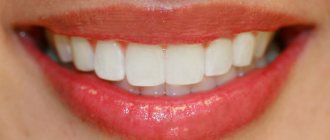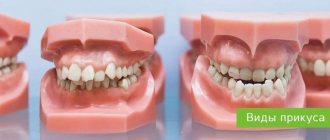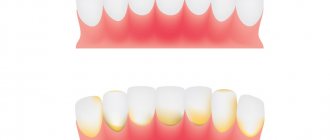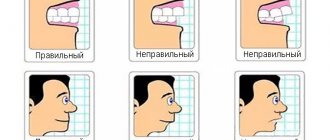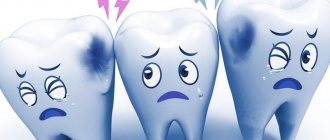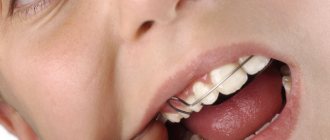The first term characterizes the natural process of closing the jaws, and the second - the arrangement of the teeth.
Separately, it is necessary to highlight the concept of central occlusion. It allows you to determine the final arrangement of the dentition, that is, the one that is formed when the jaws are completely closed. It is the position of the teeth during central occlusion that indicates that the bite is correct.
All types of closure differ in the arrangement of the dentition. Some of them are physiological and do not require correction. Others are classified as dental pathologies and can lead to serious health problems. Let's find out what a correct bite looks like in adults and children.
Signs of correct teeth bite
To understand what a person’s correct bite should be, you need to know about several types of teeth arrangement that are considered normal. These include:
- 1. Orthognathic. The top row overlaps the bottom row by 30%.
- 2. Opisthognathic. The teeth are slightly inclined towards the oral cavity.
- 3. Direct. The cutting edges of the upper teeth touch the cutting edges of the lower teeth.
- 4. Biprognathic. The teeth are slightly directed towards the vestibule of the mouth.
- 5. Progenic. The lower dentition is slightly pushed forward.
If any of the listed types of normal occlusion are detected, correction is not required. This arrangement does not lead to negative consequences and does not affect a person’s appearance.
Useful information for patients
The dream of each of us is to have beautiful and healthy teeth. In fact, having healthy teeth is not difficult at all. You just need to adhere to a number of rules:
- Visit the dentist at least twice a year - any disease is easier to prevent than to treat.
- Maintain oral hygiene - brushing your teeth in the morning and evening after meals, rinsing your mouth after each meal.
- Maintain a balanced diet - limit the consumption of sweets, as well as coffee and strong tea. Be sure to include fresh vegetables, fruits, and dairy products in your diet.
The first thing you need to know about teeth is that these organs are the only ones in the human body that cannot be restored. And their apparent fundamentality and reliability are very quickly violated by poor care and bad habits. And if primary, milk teeth are fragile precisely because of their temporary purpose, then molars are given to a person once and for life.
DENTAL FORMULA
Usually the location of the teeth on both jaws is recorded using the so-called dental formula. For baby and molar teeth, it differs only in that baby teeth are usually designated using Latin numerals, and molars - Arabic.
The dental formula for an adult looks like this: 87654321|12345678. The numbers indicate teeth - a person should have two incisors, one canine, 2 premolars and three molars on each side on each jaw. As a result, we get the total number of teeth of a healthy person - 32. In children who have not yet replaced their milk teeth, the dental formula looks different, because there are about 20 milk teeth in total.
TYPES OF TEETH
Incisors are the front teeth of a person, that is, those that are located in the very center of the jaws. There are eight of them in total - four each on the upper and lower jaws. Incisors have a single root, a flat crown and a special cutting edge. After all, the main purpose of incisor teeth is to bite (cut) food. The central incisors of the upper jaw are always larger than the lower ones. The cutting edge of the incisors of young people contains tubercles, which gradually wear off with age. The incisor teeth do an excellent job with their main task - biting off food, but in general they are the weakest and are not capable of heavy loads.
To the left and right of the incisors on each jaw are canines . It is believed that fangs were inherited by humans from predators. A feature of the fangs is the presence of a cutting edge in the shape of a tooth, reminiscent of a spear. Fangs work when a lot of force is required - with the help of fangs a person tears off tougher food. The canines have a single convex powerful crown and a single root, also distinguished by its great length and power. Due to this, and also due to its favorable location, the canine is the most stable in the dentition.
The premolars , or small molars, are located just behind the canine teeth. There are eight of them in total, four units on each jaw. Premolars are chewing teeth, as their main function is to chew and grind food. These are large teeth, rectangular in shape with 2-4 tubercles for better grinding of food. The first painter is usually larger than the second in size, but is no different from him in function. Upper premolars differ from lower premolars by having two roots instead of one.
Molars or large molars are the largest in the dentition. They are located behind the premolars and are therefore called posterior. The posterior chewing teeth - molars - have wide chewing surfaces with 3-5 tubercles. The size of the molars decreases from the first to the third. Third molars are wisdom teeth that are the last to appear in a person, and sometimes do not appear at all. The upper molars have 3 roots, the lower molars have two.
How many teeth should a person normally have? From the point of view of dental development, a person over 18 years of age, having from 28 to 32 teeth, is considered full-fledged. It all depends on whether his third molars - four wisdom teeth - have erupted or not.
For patients who want to get
a free consultation with a dentist in Krasnodar , we inform you that pre-registration for an appointment is being made at Dentistry on Gagarin. Call the numbers indicated on the website and sign up for a free consultation with a dentist with a diagnosis (consultation duration up to 15 minutes).
Malocclusions
If the position of the teeth does not correspond to any of the options listed above, then a malocclusion should be suspected. There are several types of pathological bite:
- 1. Open. In the anterior or lateral areas of the dentition, when closing, the teeth do not touch each other.
- 2. Prognathic (distal). The upper row protrudes above the lower due to underdevelopment of the lower jaw or excessive growth of the upper.
- 3. Deep. The top row overlaps the bottom row by more than 50%.
- 4. Mesial. The lower dentition overlaps the upper due to excessive growth of the lower jaw or insufficient development of the upper.
- 5. Cross. The teeth intersect in one or more zones like scissors. Can be bilateral or unilateral.
- 6. Reducing. Occurs in the absence or pathological wear of teeth.
Knowing what is a normal dental bite and what is considered an anomaly is necessary for timely consultation with a doctor and correction.
How to find out what kind of bite you have
Patients are often interested in how to determine whether their bite is correct. Usually the presence of abnormalities can be identified by facial features. It is also worth taking into account the criteria for correct bite described above. Go to the mirror, open your mouth and clench your teeth. In some cases, violations are immediately visible. Just because your smile looks aesthetically pleasing does not guarantee that everything is fine.
Even if you know what a correct bite should look like, it is impossible to make a correct diagnosis on your own. Only a specialist can do this. In addition to a visual examination and medical history, the doctor diagnoses the problem based on the results of a CT scan (computed tomography). Such an examination allows you to comprehensively assess the condition of the oral cavity. Disturbances in the placement of teeth are also identified by an impression made from an alginate mass. The orthodontist also needs photographs of the person’s face taken from several angles. Using them, you can evaluate the occlusal relationships of the dentition.
Reasons for the development of malocclusion
The reasons for the violation of the correct position of teeth can be either congenital or acquired. The main risk factors for the formation of malocclusions:
- – genetic predisposition;
- – improper breastfeeding or bottle use;
- – sucking on pacifiers, fingers or other objects in infancy;
- – congenital developmental anomalies;
- – mouth breathing for diseases of the respiratory system;
- – lack of sufficient solid food in children’s diets according to their age;
- – premature or delayed change of baby teeth;
- – lack of calcium and/or fluorine in the body;
- – trauma to the dentofacial apparatus;
- – severe caries with destruction and loss of teeth;
- – lack of space on the jaw for cutting figure eights;
- – incorrectly installed or unsuitable dentures in adults.
Regardless of the reasons, each patient needs bite correction to restore the functionality of the dentofacial apparatus.
Metal ceramics on the front teeth –
An aesthetic problem when replacing anterior teeth with metal-ceramics is associated with the presence of a metal frame under the surface layers of the ceramic mass. The first problem is that the ceramic layer must be made opaque - otherwise the metal frame will be visible through the ceramic layer. In turn, dental tissues have a certain light transmittance - enamel is capable of transmitting about 70% of light, and the dentin lying under the enamel is about 30%.
Such optical properties give natural teeth a certain degree of transparency, as well as color, which also changes from the cutting edge to the neck of the tooth. Therefore, when metal-ceramic crowns are installed on one or two front teeth, in most cases they are noticeable against the background of natural teeth. Therefore, if we are talking about budget metal-ceramics, this problem can be more or less solved only if you install metal-ceramics on all 6-8 front teeth at once, and in this case, all the front teeth under the crowns will look at least the same.
If you have a sufficient budget, the problem of color and transparency can be solved by using more expensive ceramic mass, the use of which, however, will significantly increase the cost of crowns. Among the best options (according to many of our colleagues) are the ceramic masses “Vita” (Germany) and “Noritake” (Japan), as well as “Ivoclar” (Liechtenstein). The use of a good ceramic mass allows us to minimize the difference between metal-ceramics and natural teeth, but again, only to a certain extent.
Clinical case No. 1 (before and after photos) –
In Fig. 3-4 you can see how one terrible metal-ceramic installed on all the upper teeth was replaced with almost the same terrible one (the crowns look gray, there is no gradient of color and transparency; as if they were made of plastic). More or less, the only thing that saves the situation is that all the upper teeth look the same, because... They all have the same crowns. In fact, in this case, metal-ceramics are more like cheap plastic crowns.
Clinical case No. 2 (before and after photos) –
In Fig. 5-6 you can see that all 6 lower metal-ceramic crowns - 1) have an unnatural gray-milky color, which is especially visible on the fangs, 2) there is no transparency along the cutting edge, 3) there is no color transition from the neck of the tooth to the cutting edge . The situation is saved again only by the fact that all 6 front teeth are taken under crowns - which makes them at least identical. On the other hand, we must admit that many patients are quite satisfied with this level of aesthetics.
Important: it should also be noted that the transparency of tooth enamel can vary greatly from person to person. Therefore, if the enamel is highly transparent, metal ceramics will not suit you at all. But if your teeth have low enamel transparency, then high-quality metal-ceramics may be a good option. But in any case, keep in mind that in bright natural light, the difference in color and transparency between metal-ceramic crowns and “your teeth” will be most noticeable. It is also worth considering that metal ceramics will have a stronger effect in patients with a gummy type of smile, i.e. when the crowns of the teeth are completely exposed when smiling.
Another disadvantage of metal ceramics on the front teeth –
However, the lack of a gradient of color and transparency (which can be found in most cases of manufacturing budget metal ceramics) is not its only aesthetic problem. Many patients almost immediately after prosthetics note that the gums around the crown have become bluish (Fig. 7). Also, after several years, many patients notice that the gums have receded, exposing the subgingival edge of the crown at the neck of the tooth - which looks like the “dark line” in Fig. 8.
Disadvantages of economy class metal ceramics:
Patients react calmly to such things if they occur in the area of the chewing teeth. But on the front teeth, especially if the patient has a gummy type of smile (that is, the gums are exposed while smiling) - this is a serious aesthetic problem. All this arises due to the fact that the lower edge of the metal frame of a metal-ceramic crown is usually not insulated with ceramic mass. It is the contact of the metal with the gum that leads to a change in its color, and also contributes to gum recession and exposure of the edge of the crown.
However, such problems with gum aesthetics are typical only for standard economy-class metal-ceramic crowns. There are metal-ceramic crowns with a much higher level of aesthetics - the so-called metal-ceramics of increased aesthetics.
Metal ceramics of increased aesthetics –
To create high-quality, highly aesthetic metal-ceramics, you certainly need an expensive, high-quality ceramic mass, which will significantly increase the cost of such crowns.
However, this is not enough, because in order to also exclude the appearance of cyanosis of the gums or a dark line, it is necessary to manufacture metal-ceramics with “shoulder mass” (Fig. 9). For crowns with shoulder mass, the metal frame will be insulated with ceramics, including in the area of the ledge (where the crown wraps around the neck of the tooth), i.e. slightly below the edge of the gum. Moreover, isolation can be carried out either along the entire perimeter of the cervical part of the crown, or only on its front side, which is already good. Isolating the edge of the metal frame with ceramics helps to avoid the development of cyanosis of the gums and the appearance of a dark line in the future.
Clinical case No. 3 – before and after photos
In Fig. 10-11 we see a decent option for metal-ceramic prosthetics, which was installed on the 4 upper incisors (there is even transparency along the cutting edge). Additionally, the patient had teeth whitening. As we can see, there are practically no differences in the color and transparency of metal-ceramic crowns from your own teeth (although minor flaws will still be noticeable to professionals).
It should be noted that modern metal-ceramic crowns (thanks to the latest generation of ceramic compounds) can be almost as aesthetically pleasing as ceramic ones. But this requires expensive materials, and most importantly, a highly professional dental technician who must have artistic talent. And there are only a few such technicians even in Moscow and St. Petersburg. And in any case, the cost of 1 unit of highly aesthetic metal ceramics (in clinics where the best specialists work) will be no less than 25,000 rubles.
Ways to correct a bite
Treatment of pathological occlusion is prescribed by an orthodontic doctor. You need to contact him as early as possible, since it is much easier to restore the normal position of teeth in childhood. The correction method depends on the age, type of pathology, and individual characteristics of the patient.
The following types of treatment are used:
- 1. Trainers, orthodontic plates and other devices for children. They allow you to set the correct growth of teeth, promote adequate development of the jaws and muscle frame.
- 2. Bracket systems. Fixed structures that are used only for permanent teeth. Helps move teeth in the right direction.
- 3. Aligners. Removable structures, which are transparent mouth guards. Bite correction occurs by gently shifting teeth when changing from one set of trays to another.
- 4. Surgical treatment. It is used when there is no effectiveness from conservative methods.
Our clinic uses only proven bite correction technologies. Doctors use high-quality and durable braces, aligners from well-known manufacturers, comfortable trainers and other devices.
Summary: which crowns are best for the front teeth?
And now the most difficult thing remains - it is easy to answer the question about the best choice of crowns for the front teeth. By the way, if you don’t go into the issue of price, the choice will be quite simple (the cost of all the above types of crowns – see the links above). The most budget option is metal ceramics, the price for 1 Unit of which starts from approximately 10,000 to 12,000 rubles.
At the same time, highly aesthetic metal-ceramics will cost you from 20,000 to 25,000 rubles (for 1 Unit), which, in principle, already corresponds to the lower price limit for ceramic crowns from Emax Press. In general, the economical option for crowns for the front teeth is only metal-ceramics, or the only option left is temporary crowns made of Multi-PMMA plastic, which are made by milling (they last up to 2 years).
Next, we look at the optimal prosthetic options:
- If you need 1 or several single crowns, in this case it is optimal to choose pressed ceramics Emax. Slightly less optimal are zirconium crowns, the frame of which is milled from pre-colored “Multi-layer” zirconium dioxide, on top of which layers of porcelain will be applied.
- Prosthetics for all front teeth at once – i.e. when we are talking about prosthetics for 8-10 front teeth (at least one jaw). In this case, it is optimal to choose monolithic zirconium crowns “Multi-layer”. The second choice is Emax ceramics, and both varieties are suitable here.
- If you need a bridge, the E.max PRESS pressed ceramic bridge is an excellent choice, because... this will give very good aesthetics. But bridges from this material can be made with a length of no more than 3 Units (i.e., only with a single missing tooth). In this case, it is important to take into account the presence and condition of the chewing teeth, because If you don't have a lot of chewing teeth, an Emax bridge may not be a good choice (it may not withstand excessive chewing pressure and break).
The second choice is a zirconia bridge. But you probably already realized that if you need to make a bridge of 4 or more units, then in any case it is made only from zirconium dioxide (Emax ceramics will not work here), or metal ceramics. At the same time, if we are talking about extended bridges for all front teeth, then it would be optimal to use monolithic zirconium dioxide “Multi-layer”.If we are talking about a bridge prosthesis of short length, then from an aesthetic point of view it is better to make the bridge non-monolithic, i.e. in this case, only the frame is milled from “Multi-layer” zirconium dioxide, which is then lined with layers of porcelain mass. But in this case, there is a small risk of porcelain chipping (in 10% of cases within 5 years of operation), but the chips are still repairable.
Additional recommendations –
From an aesthetics point of view, the situation when you are replacing symmetrical teeth with crowns (for example, 4 central incisors at once or a group of 8-10 front teeth at once) is simpler, and in this case you can choose more economical prosthetic options.
The most difficult options are when you need to take only 1 front tooth or 2-3 teeth, asymmetrically located in relation to the center of the dentition (24stoma.ru). The latter is due to the fact that the human eye primarily pays attention to the differences between symmetrical objects. In addition, if you have a gummy type of smile (the gums are exposed when you smile), this will also require choosing more expensive crown options than in patients whose only the incisal edges of the front teeth are slightly visible when smiling.
Choosing crowns on implants –
When prosthetics of anterior teeth supported by implants, the choice of crowns is reduced to metal-ceramics and zirconium dioxide. However, the first option will have all the usual disadvantages of traditional metal ceramics, i.e. It will be difficult to achieve good aesthetics in patients with high transparency of tooth enamel, and secondly, blueness of the gums will be guaranteed.
Therefore, the optimal prosthetic option in this case would be to choose a zirconium crown, which is installed on a zirconium abutment. You can read more about the pitfalls of prosthetics on implants in the article at the link below.
→ Choosing a crown for a dental implant, price
An example of a bite corrected with braces - photo
Conclusion
Everyone should know what the correct bite is in a person in order to respond to the problem in a timely manner. Ignoring the situation leads to many unpleasant consequences, for example, impaired diction, pathological abrasion of enamel, impaired facial symmetry, dysfunction of the temporomandibular joint and others.
When correcting your bite, you must strictly adhere to the orthodontist's recommendations. Failure to comply with prescriptions and interruption of treatment not only slows down the restoration of the bite, but can also aggravate the situation. Make an appointment at Leonid Gorbunov's orthodontic studio to check your bite and make an effective correction.
Posted by:
